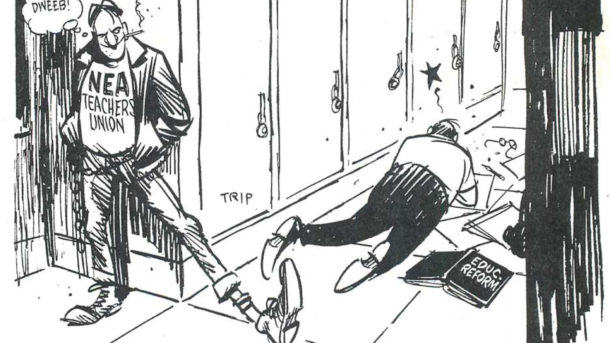Is This Any Way to Run a City’s Schools?
Leaked CTU Proposals Won’t Do Anything to Improve Schools’ Poor Performance

Union Monopolists Make Schools Less Effective
‘Substantial’ Negative Impact on Student Achievement Documented
One advantage American school reformers have over their counterparts in many other countries is that, thanks to the vertical separation of powers in the U.S. Constitution, the 50 state governments today retain a substantial degree of control over how schools are funded and managed.
Employee-employer relations may be the single most important public education policy area over which states remain sovereign.
In 21st Century America, states are still free to refuse to adopt any law instituting compulsory union bargaining in taxpayer-funded education as well as in other public institutions.
The fact is, state lawmakers benefit schoolchildren and taxpayers by refusing to hand government union bosses’ monopolistic power over public education.
Teacher Forced Union Dues Have Long Been Banned In 24 of the 50 States
In a recent policy analysis for the Washington, D.C.-based Cato Institute, University of Texas (UT) economist Stan Liebowitz and UT research fellow Matthew Kelly quantitatively demonstrate that union monopolists make schools less effective and more costly.
Thanks largely to the persistent and determined lobbying efforts of the members of the National Right to Work Committee, there is not now and there never has been a federal law forcing any state or local government employers to recognize any union as employees’ “exclusive” (monopoly) bargaining agent.
Two states, North Carolina and Virginia, actually have statutory prohibitions against any government-sector bargaining.
An additional 13 states do not currently have and never have had a court decision, statewide statute, or constitutional provision forcing K-12 public school employers to engage in any form of bargaining with any union.
Moreover, a total of 24 states have for at least the past decade-and-a-half prohibited the extraction of compulsory union dues or fees from elementary and secondary public school teachers as a condition of employment.
In other words, nearly half of the 50 states have prohibited forced financial support as a teaching job condition since before today’s high school seniors were in kindergarten.
Meanwhile, 22 states have until now statutorily authorized or (in the case of Missouri only) tolerated the firing of public school teachers for refusal to bankroll a union they never asked for, and don’t want.
Analysis Makes Apples-to-Apples Comparisons of State Educational Outcomes
Early last summer, the U.S. Supreme Court finally ruled, in a case in which National Right to Work Foundation attorney William Messenger was the civil servant plaintiff’s counsel of record, that laws and other policies forcing public employees to pay for union advocacy in order to keep their jobs violate the First Amendment.
Of course, this recent landmark High Court decision (Janus v. AFSCME Council 31) did not have any impact on any nationwide standardized test of student achievement whose results are known at this time.
To make valid comparisons of state educational outcomes, one must first of all use a standardized test that is administered to all or a random sampling of all schoolchildren at a particular grade level across the country. The test that best fits the bill is the National Assessment of Educational Progress (NAEP).
The Liebowitz-Kelly policy analysis (“Fixing the Currently Biased State K-12 Education Rankings”) drew on 2017 state NAEP results for math and reading and 2015 results for science.
(The NAEP math and reading tests are offered to fourth and eighth graders in all 50 states every two years.
The science and writing tests are offered to fourth and eighth graders every four years.)
By using the racial and ethnic information supplied by NAEP to control for demographic differences among the 50 states, Dr. Liebowitz and Mr. Kelly were able to make “apples-to-apples” state comparisons.
Most States With the Highest Educational Quality Protect Teachers’ Right to Work
According to the Liebowitz-Kelly analysis, seven of the top 10 states for educational quality (Virginia, #1, Florida, #3, Texas, #5, Georgia, #7, Wyoming, #8, Indiana, #9, and North Dakota, #10) have longstanding protections for K-12 educators’ Right to Work.
The average quality ranking for teacher Right to Work states is #22, compared to #26 for states where teacher forced union dues were still permitted until Janus.
In addition to ranking states for educational quality, Dr. Liebowitz and Mr. Kelly conducted several regression analyses in order to ascertain which factors contribute to or detract from schools’ effectiveness.
Monopolistic Unions Are ‘Negatively Related’ to Student Performance
Among the variables they studied, “union strength” (an index derived from how extensive teacher union officials’ legal privileges are and how much political clout they wield, among other closely related factors) has the most markedly detrimental impact:
“The union strength variable . . . has a substantial and statistically negative relationship with student achievement.”
Dr. Liebowitz and Mr. Kelly concluded that their research findings are “consistent” with the view that “[monopolistic] unions are negatively related to student performance . . . .”
They explained that the detrimental impact is presumably related to Big Labor bosses’ opposition to “the removal of underperforming teachers” as well as “merit-based pay,” and/or to “union work rules.”
In general, they said, “studies that most effectively control for heterogeneous student populations, as we have, tend to find more negative relationships, as those found here.”
The Liebowitz-Kelly policy analysis focused on efficiency as well as quality.
As they explained, it is “important to consider, on behalf of taxpayers, how much government expenditure is undertaken to achieve a given level of success.”
However, they wished to be fair to high cost-of-living states, “where above normal education costs may reflect price differences rather than greater extravagance in spending.”
Nine Highest-Ranking States For Educational Efficiency All Bar Teacher Forced Dues
Therefore, they calculated an efficiency rating “based on education quality per adjusted dollar of expenditure, where the adjustment is to control statewide differences in cost of living . . . .”
(The cost-of-living adjustments used by Dr. Liebowitz and Mr. Kelly were taken from the Missouri Economic Research and Information Center’s Cost of Living Data Series 2017 Annual Average.)
In the state rankings assessing how well ethnically and racially diverse students do relative to how much schools spend in cost of living-adjusted dollars, all of the nine highest-ranking states have been protecting educators’ Right to Work for more than two decades.
In order, they are: Florida, Texas, Virginia, Arizona, Georgia, North Carolina, Indiana, South Dakota and Colorado.
Six of these states — Texas, Virginia, Arizona, Georgia, North Carolina and Colorado — either do not statutorily authorize or explicitly prohibit union monopoly bargaining as well as other forms of union bargaining in K-12 public education.
The average efficiency ranking for teacher Right to Work states is #20, compared to #30 for states where teacher forced union dues were still permitted until Janus. The efficiency rankings expose the wastefulness of forced-unionism states like New York, “which spend a great deal for mediocre performance.”
Janus Court ‘Laid the Groundwork’ For School Reform in 22 States
In contrast to unionization, which is clearly “negatively related to student performance,” a state’s average class size and the share of its students who are in private schools do not appear to have a measurable impact on student performance, according to Dr. Liebowitz and Mr. Kelly.
They did identify a small positive impact from the availability of charter schools as an alternative to public schools managed directly by government officials, but it is modest compared to the negative consequences of monopolistic unionism.
National Right to Work Committee and National Right to Work Legal Defense Foundation President Mark Mix observed that the Liebowitz-Kelly study furnishes important lessons for concerned citizens and state policymakers:
“First of all, the evidence in the paper shows that, when the Supreme Court ruled that public-sector forced union dues are unconstitutional in the Janus case, it simultaneously laid the groundwork for public schools in the 22 states where teacher forced dues had been legal up to that time to improve.
“Thanks to Janus, schools in former teacher forced-dues states can do a better job of educating schoolchildren at a more reasonable cost to taxpayers.
“Moreover, the Liebowitz-Kelly findings should encourage state lawmakers in jurisdictions where monopolistic unionism continues to be authorized and promoted in public education post-Janus to eliminate or at least roll back government union officials’ special legal privileges.
“And Big Labor’s unwarranted power to codetermine with school officials how employees are compensated and managed is the key remaining problem.”

Leaked CTU Proposals Won’t Do Anything to Improve Schools’ Poor Performance

Wherever Big Labor wields the power to collect forced union dues, union bosses funnel a large share of the confiscated money into efforts to elect and reelect business-bashing politicians. Employment growth tends to lag as a consequence.

Members Insist They Keep Pro-Right to Work Campaign Promises